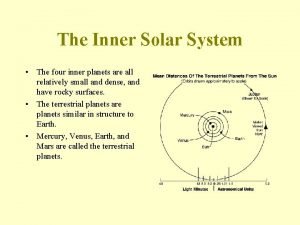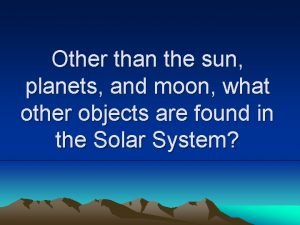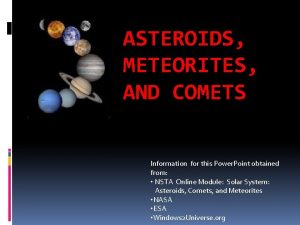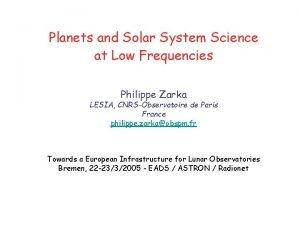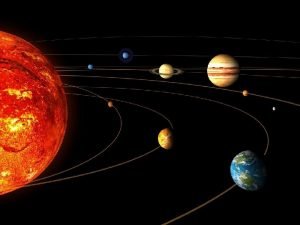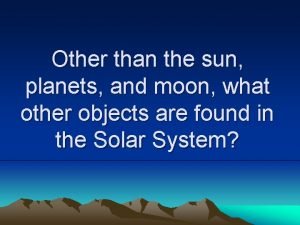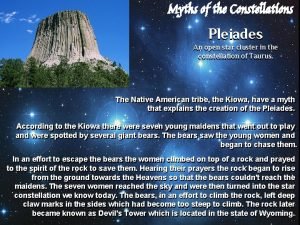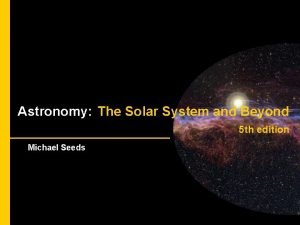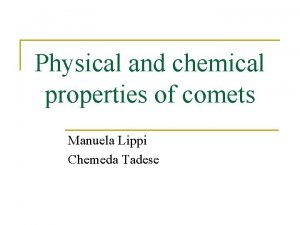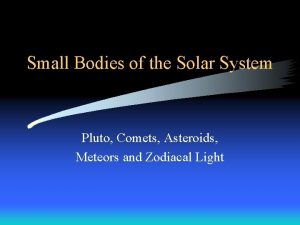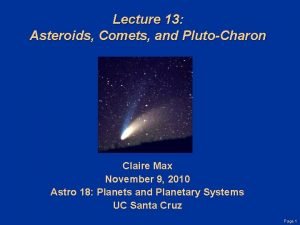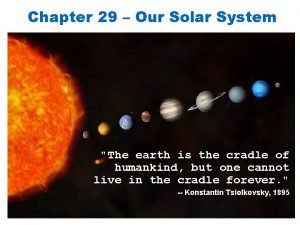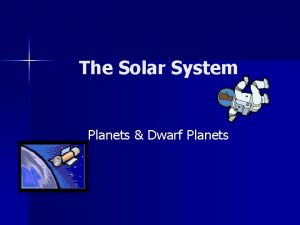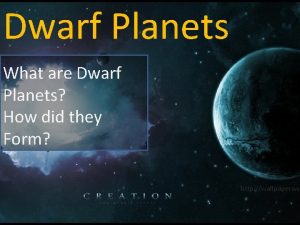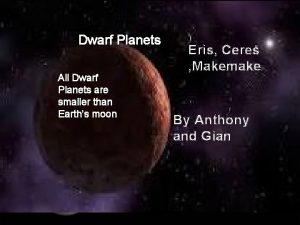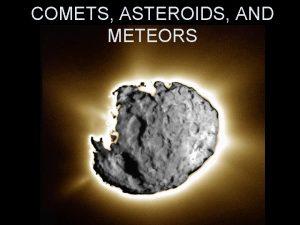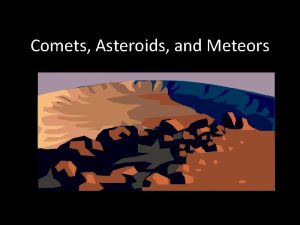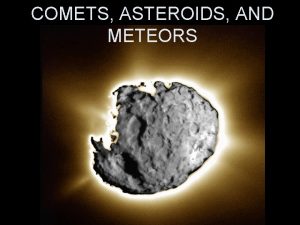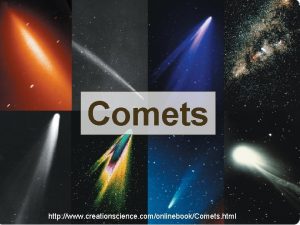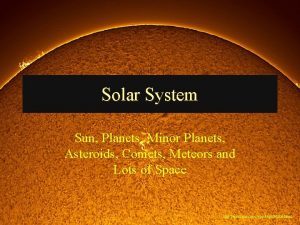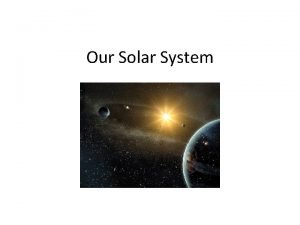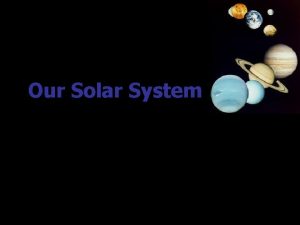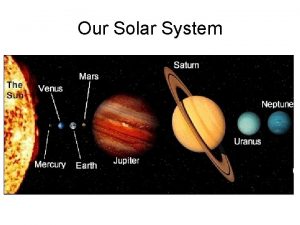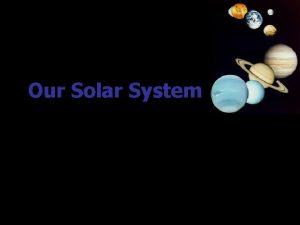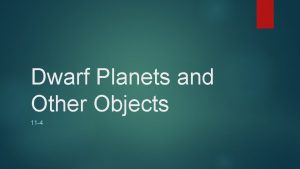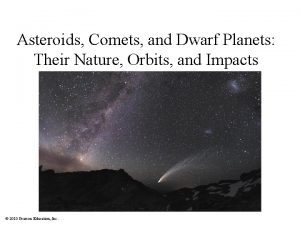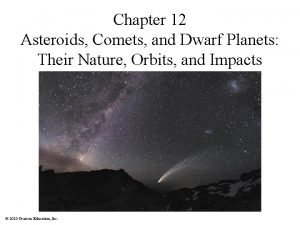Our Solar System Planets dwarf planets comets and


















- Slides: 18

Our Solar System Planets, dwarf planets, comets and asteroids all orbit the sun. . .

A note about distances. . . � The distance from earth sun is ~150 million km � Saturn is 9. 5 times further OR ~1. 5 billion km � Neptune � Very is 30 times further from the sun. . . quickly distances become too great to comprehend in kilometers, so we use the astronomical unit or AU

Astronomical Units – A. U. � 1 AU is the average distance betweent he sun and Earth � Saturn sun is 9. 5 times further so 9. 5 AU from the � Neptune the sun is 30 AU from

Planets � Celestial bodies that orbit one or more stars � Massive enough for its gravity to hold a spherical shape � Massive enough (that is has enough gravity) to clear its orbital path of debris

Terrestrial Planets � Dense and rocky � Closest to the sun � Smaller in size � Smaller orbits (shorter “year”) � Warmer average surface temperature (-63ºC to 467ºC)

Jovian Planets � “Gas giants” � Further the sun � Large in size � Larger � Cold from orbits (longer “year”) average surface temperature (-215ºC to -150ºC)

Dwarf Planets � Celestial bodies that orbit the sun with enough gravity to hold its spherical shape but. . . � They are not massive enough to clear their orbit of debris � Examples: Pluto, Eris (larger than Pluto!), Haumea and Makemake are beyond Pluto � Ceres is between Mars and Jupiter

Relative Sizes of the Dwarf Planets

Dwarf Planet Orbits

� Small, Asteroids mostly irregular shaped debris ranging from sand grain size to 1000 km across � NEAs, or Near earth asteroids, exist inside Mars’ orbit and are at risk of hitting earth � Most asteroids in our solar system are in the Asteroid Belt located between Mars and Jupiter

Asteroids and Comets � Kuiper Belt outside Neptune’s orbit has dust and up to 23 dwarf planets � Many short period comets originate here

Asteroids and Comets � Oort Cloud is a spherical cloud of small, icy fragments about 50, 000 to 100, 000 AU from the sun � Source of long period comets

Comets � “Dirty snowballs” composed of ice, rock and gas that originate from the Kuiper belt and Oort Cloud � Travel in long elliptical orbits around the sun that change due to the gravitational pull of the planets

Comets � Their long dust tail can stretch for millions of kilometers � Short period comets – periods less than 200 � Long period comets – period could be thousands of years (Hale-Bopp 4200 yrs) years

Comets � Some do impact planets in our solar system – one may impact Earth someday � Comet Shoemaker-Levy 9 crashed into Jupiter in 1994 leaving visible scars for nearly a year

Meteors � Meteoroids – pieces of rock (chunks of asteroids or planets) floating through space � Meteors ◦ “shooting stars” ◦ Meteoroids which are burning up in Earth’s atmosphere � Meteorites surface – meteors that reach Earth’s

Meteor Impact Sites � Impact sites provide evidence that meteors have hit the earth � Impact site in Arizona. . . A meteor roughly the size of a school bus hit the Earth creating a crater 1. 2 km wide and 200 m deep

Meteor Impact Sites � � � Impact site in Manicouagan, Quebec Earth’s 5 th largest confirmed impact crater at 100 km across Asteroid that hit was approximately 5 km across Chicxulub Basin in Mexico Meteor that hit here 65 million years ago wiped out half of the Earth’s organisms. . Including the dinosaurs!! 300 km across
 The four inner planets of our solar system are
The four inner planets of our solar system are My very excited mother just served us nachos
My very excited mother just served us nachos Asteroids meteors and comets worksheet
Asteroids meteors and comets worksheet Difference between comets and asteroids and meteors
Difference between comets and asteroids and meteors What are the inner and outer planets
What are the inner and outer planets Solar system planets
Solar system planets Solar system picture
Solar system picture What separates the inner planets and outer planets
What separates the inner planets and outer planets The inner solar system by leslie
The inner solar system by leslie Inner terrestrial planets
Inner terrestrial planets Asteroids meteors and comets worksheet
Asteroids meteors and comets worksheet What are the outer planets mostly made of
What are the outer planets mostly made of Are jovian planets more dense than terrestrial
Are jovian planets more dense than terrestrial Comets diagram
Comets diagram Properties of comets
Properties of comets Physical properties of comets
Physical properties of comets Comets asteroids
Comets asteroids An icy leftover planetesimal orbiting the sun is
An icy leftover planetesimal orbiting the sun is Chapter 29 our solar system
Chapter 29 our solar system
